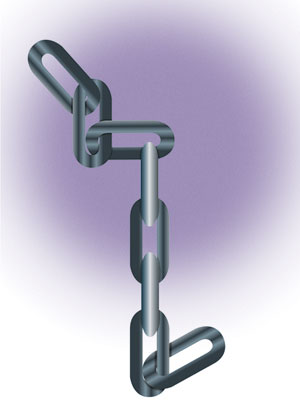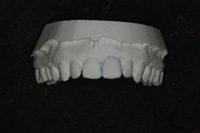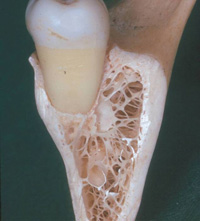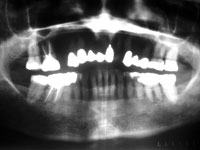At first, a commitment to the interdisciplinary approach to patient care can be intimidating for many dentists and practices. You may think that it will take up too much time, be too complicated, or overwhelm your patients. In reality, it is exactly the opposite. By taking the initiative to create an interdisciplinary team, you will save time and energy in the long run by streamlining and simplifying the process of referrals and working with other specialists. Most importantly, you will be ensuring that your patients receive the best possible care at every step of the treatment process.
WHAT IS THE INTERDISCIPLINARY APPROACH?
 |
|
llustration by Cheryl Gloss
|
We already know that the dentist alone cannot always solve some of the more complex oral, cranial, and facial problems from which patients suffer. This is when the dentist will traditionally refer his or her patient to a specialist in order to seek additional expertise. In a particularly complex case, there may be several referrals to several different specialists over the course of treatment. This multidisciplinary approach to treatment can be very effective, as one specialist cannot deal with all aspects of a complicated problem. However, it can be a bit one-sided, since information travels between the dentist and the specialist(s) without any time or place dedicated to collaboration. The interdisciplinary approach brings in that missing collaborative element and allows all specialists involved to conduct a dialogue concerning patient care.
Interdisciplinary dentistry focuses on interaction, not only between the primary dentist and the specialists, but also between the interdisciplinary team and the patient. The patient should always be included in the process as a member of the team and should be updated regularly on incoming information and decisions. Including the patient in this way not only brings treatment to a new level, but it also provides optimal customer service from the dental practice.
The interdisciplinary team creates a network of shared skills and expertise, open communication, and trust. The ultimate goal is to create and perpetuate an ideal treatment environment in which the patient feels comfortable and doctors can work effectively.
HOW DOES THE INTERDISCIPLINARY APPROACH WORK?
As we know, a dentist already wears many hats within his or her practice: business owner, boss, clinician, customer service provider, manager, and leader. With these responsibilities already in place, it is easy to view interdisciplinary dentistry as extra work that could be handled just as well with simple referrals. Even though establishing the interdisciplinary team may require an extra time investment up front, once the team is in place it provides a much more effective framework for treatment. It also opens the lines of communication, reducing stress and confusion for all members of the team, including the patient. Clear expectations of the intended treatment outcome are built into the interdisciplinary team’s framework. As a result, and by its very nature, the team approach allows for more efficiency and a better treatment outcome.
The initial formation of the ideal interdisciplinary team can require a considerable amount of time and energy. However, it will be worthwhile to your practice to create that valuable network of specialists on whom both the dentist and the patient can rely. Team members should meet at the beginning to discuss the patient’s diagnosis and treatment plan together. By combining the individual skills and expertise of all the specialists, a comprehensive treatment plan can be developed. As with any sort of collaborative effort, the interdisciplinary team can benefit from a written agreement delineating all responsibilities, expectations, and financial compensation.
The team should discuss every aspect of the treatment plan in detail and ensure that the plan is customized to the patient’s needs. Then, at every step of the process, all members of the team will follow the treatment plan. It is important to remember that the patient is an essential part of the team and should be included in the development and execution of the treatment plan. Once an atmosphere of open communication has been established, it is much easier to avoid mistakes and confusion during the treatment process. The key is to start the interdisciplinary process before problems arise and not after. Rather than making referrals and then subsequently engaging in dialogue with specialists should a problem arise, be sure to collaborate actively with the other members of the team at the onset of treatment. Be sure that all members of the team are working together on all the steps of the treatment plan.
The beauty of collaborative work is that everyone can give each other advice and build on each other’s ideas. Rather than passing down orders, team members can ask for input and suggestions. Again, be sure to engage the patient in the dialogue. Instead of commanding your patient to do something, ask the patient if he or she would be comfortable with a given method of treatment. Do not hesitate to consult other members of the team if a problem arises. Overlooking something or misdiagnosing a patient can lead to a lack of treatment or unnecessary multiple treatments, which can be ineffective at best and harmful at worst.
CUSTOMER SERVICE AND THE INTERDISCIPLINARY APPROACH
Once your interdisciplinary team is in place, it will be a valuable resource for both your practice and future patients. Learning about alternative treatments and options will allow you to greatly increase your level of patient care. Sometimes traditional dentistry is not the only solution, and in those cases your established interdisciplinary team can be available to help develop a personal treatment plan for your patient.
The interdisciplinary approach to dentistry can have a major impact on your practice, not only in treatment of your patients, but also in your level of customer service. By including your patients in the dialogue and development of their treatment plans, they will begin to develop personal relationships with the dentist and specialists. Trust will grow from these relationships, and the patient’s level of trust in the team will steadily increase as long as the lines of communication remain open and as the ex-pected outcomes of the treatment plan are met. The objective is to make your patients feel secure in their treatment, and that by working together to create highly individualized treatment plans, their goals will be met. Your patients will feel valued and respected, and in turn they will value and respect their treating clinicians. These patients will be sure to return to the practice and the team for future treatment.
Once your practice fully embraces the interdisciplinary approach, you will reap the benefits. Not only will your treatment plans for complex problems be more comprehensive and effective, but your patients will be receiving optimal care and customer service, as you will be anticipating their every need. Ultimately, the interdisciplinary team is not about what fellow specialists can do for you, but what you can all do collaboratively for your loyal patients.
Sources
Israel HA, Scrivani SJ. The interdisciplinary approach to oral, facial and head pain. J Am Dent Assoc. 2000;131:919-926.
Murphy MT. Collaborative interdisciplinary agreements: a new paradigm in laboratory and specialist communication and patient care. J Am Dent Assoc. 2006;137:1164-1167.
Spear FM. Forming an interdisciplinary team: a key element in practicing with confidence and efficiency. J Am Dent Assoc. 2005;136:1463-1464.
Hanley Y. Inter-disciplinary dentistry persists as a challenge for rural dentists. Dent Econ. 2005;95(2).
Varallo M, Varallo V. Killer customer service: beyond satisfaction. Dent Today. Oct 2007;26:142-144.
Dr. Varallo is a 1980 graduate of Farleigh Dickenson Dental School in New Jersey. He is a member of the International Academy for Dental-Facial Esthetics, an AGD-trained speaker, an associate fellow of the World Clinical Laser Association, and serves on the Clinical Advisory Board for DENTSPLY. He owns and operates the Nantucket Dental Society. Dr. Varallo runs a patient-centered practice in Ho Ho Kus, NJ. He can be reached at (201) 670-9076.











